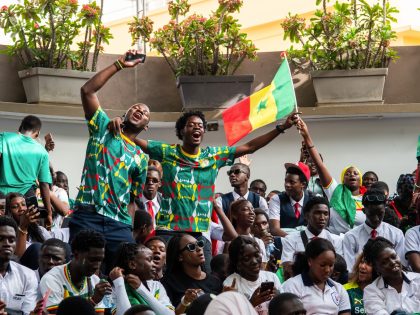The West are not those most affected by terrorism
Malian director Abderrahmane Sissako’s film "Timbuktu" complicates the Jihadist narrative in Africa.

A still from Sissako's "Timbuktu."
Abderrahmane Sissako’s Timbuktu begins with a scene of a truck of armed jihadists chasing a gazelle. One screams to the other, “Don’t kill it. Tire it out.” It’s a fitting metaphor for the occupation of northern Mali. For, it represents the gradual, often confounding, regulations and punishments that jihadists enforced in the name of shari’a (law). It also represents the physical, economic, and emotional exhaustion that so many Timbuktians experienced under the occupation.
Timbuktu, which opened in the United States on January 28, centers on a Tuareg family living in a tent on the outskirts of Timbuktu. Both honor and fatigue make the family reluctant to flee with their family and friends. This leaves them worried and lonely. It also makes them vulnerable to the jihadist regime, as well as fellow Timbuktians, who are equally frightened and on edge. But the film also highlights other residents—including locals and jihadists—as they negotiate the demands of the occupation.
Many film critics have lauded Timbuktu as a “visual masterpiece,” praising Sissako’s use of vast landscapes and captivating cityscapes. However, the cinematography accomplishes more than stunning images. Instead, it evokes the loneliness, confusion, desperation and sense of abandonment that so many Timbuktians experienced. Who could they rely upon and trust aside from the few who remained? How were residents supposed to gauge the jihadists’ often conflicting motives?
Others critics have also applauded the film’s supposed comedic and satirical script. Such praise is somewhat misleading in my opinion. Timbuktu does not portray the jihadists—at least not all of them—as either purely ideological or bumbling buffoons. Many are depicted as critical thinkers in their own way. Others—(former) lovers of rap music and soccer—are depicted as youths who are way over their heads. Contrary to certain criticism following the Charlie Hebdo attack, however, this is not to suggest that Sissako is an apologist for extremism. Far from it. Instead, he depicts the jihadists as real, not as a caricature.
Sissako also demonstrates local resistance to shari’a. He includes a scene of a fishmonger critiquing new regulations that force her to wear gloves. And he includes another of lower-level jihadists searching for singers and guitar players. Some viewers and critics find these scenes amusing, and perhaps they were partially intended to be. Nonetheless, rules enforcing public veiling and prohibiting music were far from amusing to the Timbuktians with whom I worked in 2013. And as Sissako accurately illustrates, the jihadists brutally countered these local expressions of resistance.
Timbuktu is not a documentary… which is not to suggest that it should be. The film excellently depicts many of the hardships that Timbuktians encountered under the occupation. It also excellently depicts the numerous creative ways in which locals—particularly women—subtly and not so subtly rejected shari’a. But viewers should remember that Timbuktu is very much in medias res. Aside from a scene of a brief conversation with a Tuareg mercenary from Libya, there is little historical or regional context, which is perhaps a means to avoid a more complicated discussion of the role of the MNLA and Tuareg-led independence movements. Furthermore, the occupiers are regularly referred to as “jihadists”. This is surely what they called themselves. And it also facilitates Sissako’s critique of religious extremism. Nonetheless, I think it’s important to consider that most Timbuktians themselves refused to identify the occupiers with Islam. Almost every time I referred to them as “jihadists” or “Islamists”, my friends would (sometimes angrily) correct me, saying, “No, these people know nothing about Islam. This is not Islam. They are terrorists, pure and simple.” Of course, it’s not that simple. But it is important to reflect upon this local perspective while viewing Timbuktian characters on screen critique the occupation.
Many of my Timbuktian friends were disappointed that Timbuktu’s global transformation from “mythical town” to “real place” occurred as a result of terrorism. Similarly, I find it somewhat unfortunate that this is the context for what is more or less the town’s contemporary cinematic debut. Nonetheless, Sissako tells an incredibly accurate story of Timbuktu. Without romanticizing it, we find an urban center that is also equal parts Sahara Desert and Niger River. We find a place of ethnic and linguistic diversity that has historically championed cosmopolitanism and more moderate expressions of religion. What Sissako’s Timbuktu highlights—and perhaps this is the film’s most important lesson—is that, despite inflammatory rhetoric that suggests otherwise, those in the West are not those most affected by terrorism. Those who are regularly forced to confront such violence are in Mali, Nigeria, Cameroon, Somalia, Libya, not to mention Syria and Iraq, places that rarely make it into the Western press.



















